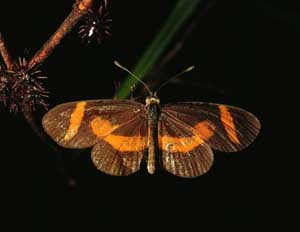|
|
 74 geography? DHJanzen100238.jpg high resolution
|
|
|
This is a common neotropical nymphalid butterfly (Microtia elva). Whether model or mimic is unknown (it is probably a model), but what IS known is that it occurs on another tropical continent. Its tropical predators never see the butterflies in the two images above (DHJanzen100236.jpg and DHJanzen100237.jpg), and vice versa. I can tell you from personal experience that in the field and flying, all three of these butterflies are very similar (and all three live in low insolated herbaceous vegetation). But this butterfly is not really a mimic of the two above. Now, having said that, do contemplate something. There was a time when Africa and South America were one, and then for a long time separated by just a narrow strait of ocean. Could all three of these butterflies, and their resemblances, date back to a time in common, a habitat in common, a set of predators in common? The alternative is that the orange and black pattern is the coincidental result of natural selection for an ostentatious flag that says something to a dimwitted bird. |
||
back to lecture slides
or skip to: